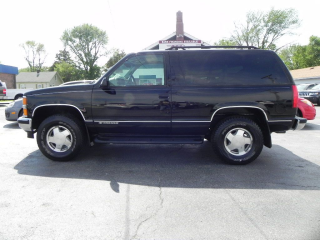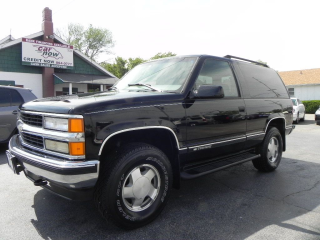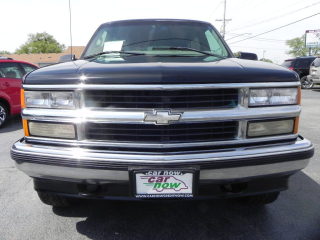The Good
The 1998 Chevrolet Tahoe offers robust V8 performance for towing and hauling, appealing to practical buyers. Its solid reliability and readily available, affordable parts make it a smart used purchase. Emotional buyers appreciate its classic, rugged design and comfortable, spacious interior, evoking a sense of adventure and enduring American utility. It delivers substantial value as a versatile, dependable workhorse.
The Bad
Key weaknesses of the 1998 Chevrolet Tahoe include notably poor fuel economy and brakes that can be undersized, leading to frequent wear. Rust is a significant concern, especially in salt-belt regions, often affecting the frame and body panels. Watch out for common wear in steering components like idler and pitman arms, and potential intake manifold gasket leaks.
1998 Chevrolet Tahoe: Quick Overview
- Engine Options: The primary engine for the 1998 Chevrolet Tahoe was the venerable 5.7L Vortec V8 (L31), renowned for its strong torque and durability.
- Horsepower: This 5.7L Vortec V8 produced 255 horsepower at 4600 rpm.
- Torque: It delivered a robust 330 lb-ft of torque at 2800 rpm, ideal for hauling and towing.
- Fuel Economy: Fuel efficiency was not a strong suit. Expect approximately 12-13 MPG in the city and 16-17 MPG on the highway for 2WD models, and slightly lower for 4WD variants (around 11-12 city / 15-16 highway MPG).
- 0-60 Times: The 0-60 mph acceleration typically ranged from 8.5 to 10 seconds, depending on the drivetrain, two-door versus four-door configuration, and specific gearing.
- Towing Capacity: The Tahoe boasted a substantial towing capacity, generally ranging from 6,500 to 7,000 lbs when properly equipped, making it a capable workhorse for trailers and boats.
- Trim-Level Features:
- Base: This entry-level trim typically offered essential features such as cloth upholstery, manual windows and locks (though power options were becoming more standard even on base models by '98), and an AM/FM stereo.
- LS: A popular mid-range trim, the LS added conveniences like power windows, power door locks, power mirrors, remote keyless entry, air conditioning, cruise control, improved cloth or optional leather seating surfaces, and alloy wheels.
- LT: The top-tier LT trim provided a more luxurious experience. It included all LS features plus standard leather seating, a power-adjustable driver's seat, automatic climate control, a premium sound system (often Bose), an auto-dimming rearview mirror, fog lights, and often body-colored bumpers and chrome exterior accents. Early versions of OnStar were also available on the LT.
1998 Chevrolet Tahoe Specifications
Vehicle Information
| Year | 1998 |
| Make | Chevrolet |
| Model | Tahoe |
| Trim | - |
| Style | 4-Door 2WD |
| Type | Sport Utility Vehicle |
| Category | Standard Sport Utility Vehicle |
Manufacturing Details
| Made In | United States |
| Manufacturing City | SILAO |
Dimensions
| Doors | 4-Door |
| Curb Weight | 4911 pounds |
| Gross Vehicle Weight Rating | 6300 pounds |
| Overall Height | 72.80 inches |
| Overall Length | 199.60 inches |
| Overall Width | 76.80 inches |
| Wheelbase Length | 117.50 inches |
| Standard Seating | 6 |
Engine & Performance
| Engine | 5.7-L V-8 OHV 16V |
| Engine Size | 5.7L |
| Engine Cylinders | 8 |
| Transmission | 4-Speed Automatic |
| Transmission Type | Automatic |
| Transmission Speeds | 4-Speed |
| Drivetrain | Rear-Wheel Drive |
Additional Features
| Anti-Brake System | 4-Wheel ABS |
| Steering Type | Recirculating |
Pricing
| Manufacturer Suggested Retail Price (MSRP) | $29,385 |
| Invoice Price | $25,712 |
| Delivery Charges | - |
Vehicle History Report
Specifications
History
Events
History Check
Check
Check
Check
Check
Listings
Recalls
Check
Analysis
What Problems Does the 1998 Chevrolet Tahoe Have?
Suspension and steering components are wear items that often require attention; specifically, the pitman arm, idler arm, and ball joints are prone to wear, leading to loose steering and clunking noises. The brake system, while functional, often sees issues with front brake rotor warping and rapid pad wear due to the vehicle's weight. Electrical gremlins can manifest over time, including failing power window motors, unreliable dash gauges (particularly the speedometer and fuel gauge), and aging wiring.
Rust is a significant long-term concern, especially in areas exposed to road salt. The frame, rocker panels, wheel wells, and tailgate are common rust spots. The A/C system can also suffer from leaks in lines and compressor failures over its lifespan. While specific recalls for the 1998 Tahoe might vary, the GMT400 platform had a notable recall concerning the cruise control deactivation switch, which could pose a fire risk due to electrical shorting. Other recalls have included issues with seat belt buckles or wiper motors. Overall, the core engine and transmission are durable, but ancillary systems, electrical components, and wear items demand consistent maintenance as the vehicle ages, contributing to its "old truck" reliability profile.
How long will the 1998 Chevrolet Tahoe last?
However, long-term durability is challenged by several weaknesses that emerge over time. Rust becomes a major concern in areas with harsh winters, affecting the frame, body panels, and brake lines. Interior components like dash plastics, door panels, and headliners often show significant wear and cracking. Steering and suspension parts (like ball joints and control arm bushings) will require regular replacement, and fuel system components, including the notorious fuel pump, are prone to age-related failures. Electrical issues, such as power accessory malfunctions, also become more common with age.
What Technology & Safety Features are Included?
Built-in Tech: This largely consisted of basic, analog instrumentation. Higher trims, specifically the LT, could include optional automatic climate control for enhanced comfort. An early version of GM's OnStar system, a subscription-based service offering emergency assistance and navigation, was available as an option on the LT trim, representing a cutting-edge feature for its time.
Entertainment: Standard entertainment typically included an AM/FM stereo. Optional upgrades often featured a cassette player, a single-disc CD player, and on higher trims, a premium sound system (such as Bose) to improve audio quality.
Driver-Assistance: Modern driver-assistance features like blind-spot monitoring or adaptive cruise control were non-existent. The Tahoe's "assistance" was limited to fundamentals like power steering, power brakes, and conventional cruise control.
Safety Features: Standard safety features for the 1998 Tahoe included dual front airbags for the driver and passenger, providing basic frontal impact protection. A 4-wheel Anti-lock Braking System (ABS) was also standard, aiding in maintaining steering control during hard braking. Daytime Running Lights (DRLs) were a common feature, improving visibility. The body-on-frame construction inherently provided a degree of passive safety and crash energy absorption.
Crash-Test Ratings: According to the National Highway Traffic Safety Administration (NHTSA) crash tests for the GMT400 platform SUVs (similar to the Tahoe):
- Frontal Driver: 3 out of 5 stars
- Frontal Passenger: 3 out of 5 stars
- Side Driver: 3 out of 5 stars
- Side Rear Passenger: 4 out of 5 stars
What Colors Options are Available?
1998 Chevrolet Tahoe Prices and Market Value
Depreciation insights show the Tahoe experienced the steepest drops in value during its first 10-15 years. Now, at over two decades old, its depreciation has largely stabilized. Resale value is heavily influenced by several factors: overall condition (especially the presence or absence of significant rust), mileage, documented maintenance history, and trim level (LT models typically hold more value). Two-door models, while rarer, can sometimes attract enthusiast premiums. A clean, unmolested, and rust-free example will always command a significant premium.
1998 Chevrolet Tahoe Cost of Ownership
In summary, the 1998 Tahoe is not economical to own primarily due to its high fuel consumption. While parts are cheap, frequent, age-related repairs can make it costly if you rely on professional mechanics. It's more economical for owners with mechanical aptitude willing to perform their own maintenance.
1998 Chevrolet Tahoe Fuel Efficiency
1998 Chevrolet Tahoe Safety Rating
NHTSA
IIHS
1998 Chevrolet Tahoe Warranty
Basic
Powertrain
Rust
1998 Chevrolet Tahoe Insurance
reasonable repair costs.
How Does the 1998 Chevrolet Tahoe Compare to Other Sport Utility Vehicle?
In terms of Performance, the Tahoe's 5.7L Vortec V8 offered strong, reliable power for its size, comparable to the Expedition's Triton V8s. The Tahoe felt distinctly truck-like, whereas the Expedition, with its independent front suspension, often provided a slightly more refined ride. Both excelled in towing and off-road capability.
Regarding Features, all these full-size SUVs were similar for their era, focusing on practicality and comfort rather than advanced tech. The Tahoe's LS and LT trims offered power accessories, air conditioning, and optional leather, which the Expedition and Yukon also matched. The Land Cruiser, however, often came with a higher level of standard luxury and renowned off-road technology, reflecting its higher price point.
Reliability is where distinctions emerge. The Tahoe's core powertrain (5.7L V8, 4L60E transmission) is generally robust, but it's plagued by common issues like fuel pump failures and intake manifold gasket leaks. The first-generation Expedition had its own known issues, including spark plug ejection on some Triton engines and transmission concerns. The Toyota Land Cruiser typically boasts a superior reputation for bulletproof reliability, but parts can be more expensive and specialized.
Price-wise, the Tahoe, Yukon, and Expedition were closely matched new. On the used market today, the Tahoe/Yukon often present excellent value. A comparable Land Cruiser of the same vintage will typically command a significantly higher price due to its legendary reliability and perceived prestige.
Recommended Alternatives:
- GMC Yukon: Essentially the same vehicle as the Tahoe, offering identical performance and reliability but with slightly different styling and trim options.
- Ford Expedition (1st Gen): A strong competitor if you're open to a different brand, offering similar utility with a slightly different driving feel due to its independent front suspension.
- Toyota Land Cruiser (80-series or 100-series): For those prioritizing ultimate reliability and exceptional off-road prowess, and with a larger budget, the Land Cruiser is a superior, albeit more expensive, choice.
- Later GMT800 SUVs (2000+ Chevrolet Tahoe/GMC Yukon): If budget allows, stepping up to the next generation offers significant improvements in ride quality, interior refinement, and safety features.
Final Verdict: Is the 1998 Chevrolet Tahoe a Good Sport Utility Vehicle?
It is absolutely worth buying used, but under specific conditions: prioritize well-maintained, rust-free examples, ideally with documented service history. Buyers must be prepared for ongoing maintenance requirements typical of a vehicle its age and significant fuel costs. Opt for LS or LT trims for better comfort and features. It's less suited for those seeking modern luxury, cutting-edge safety, or superior fuel efficiency, but excels as a utilitarian workhorse or a secondary vehicle for heavy-duty tasks.



